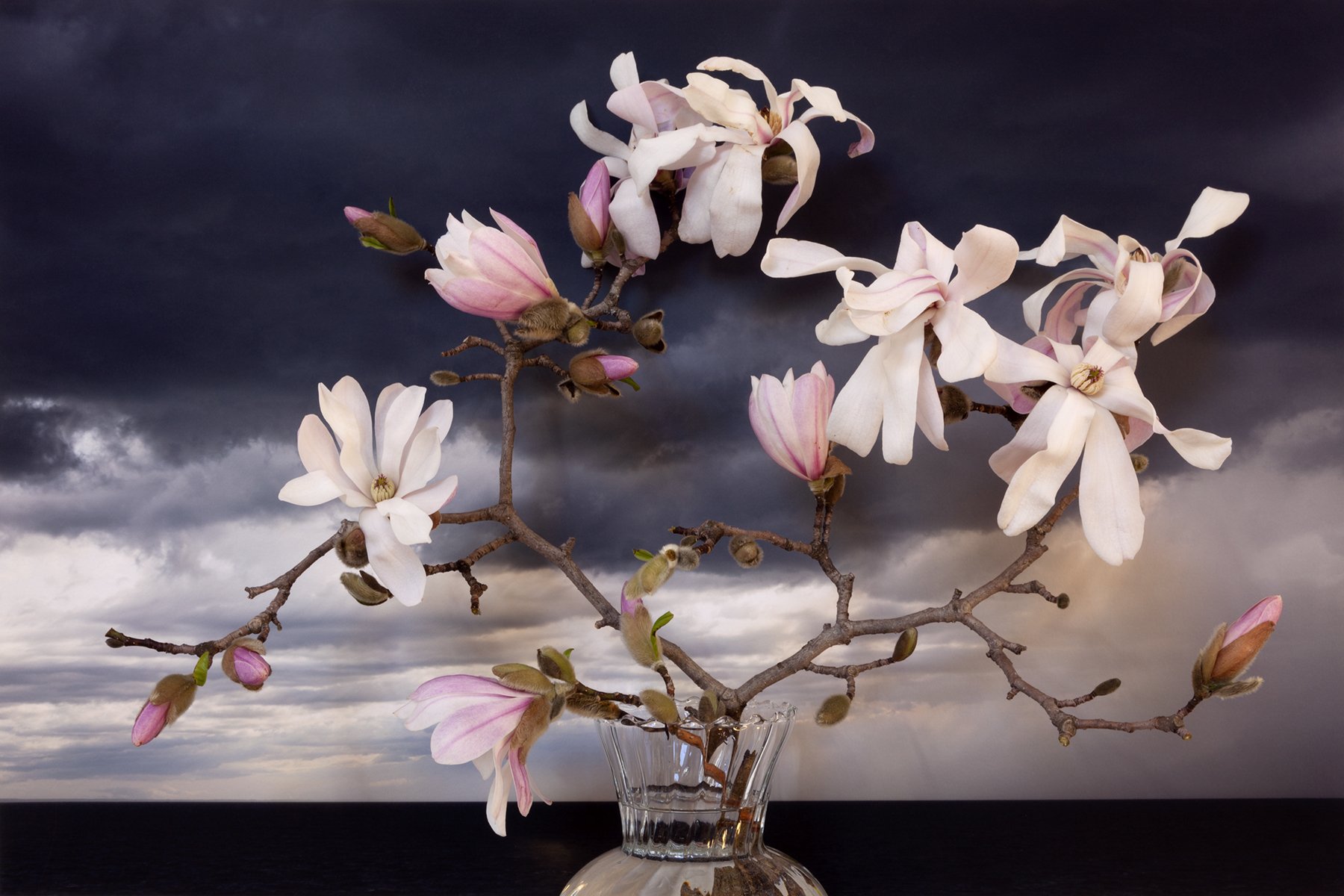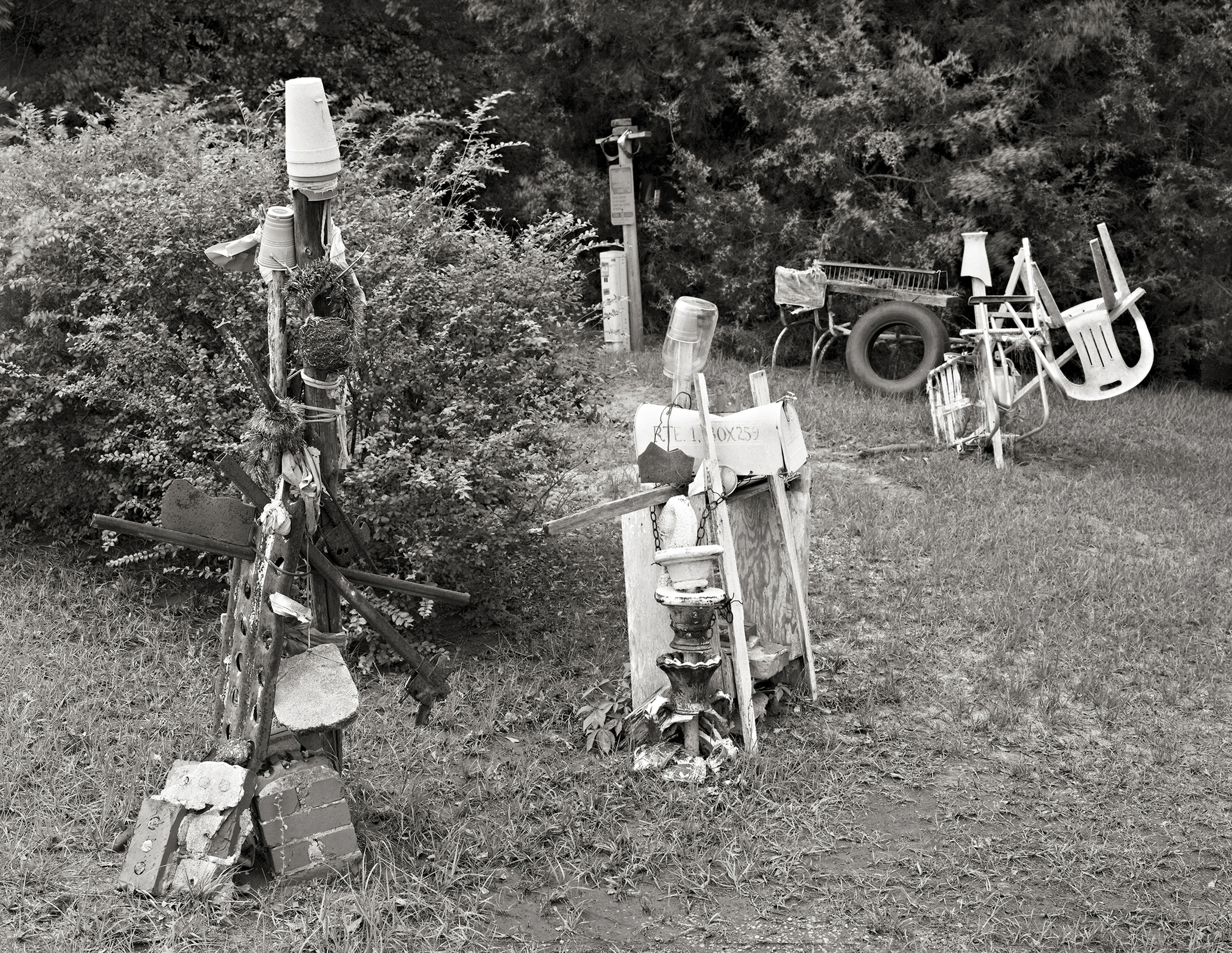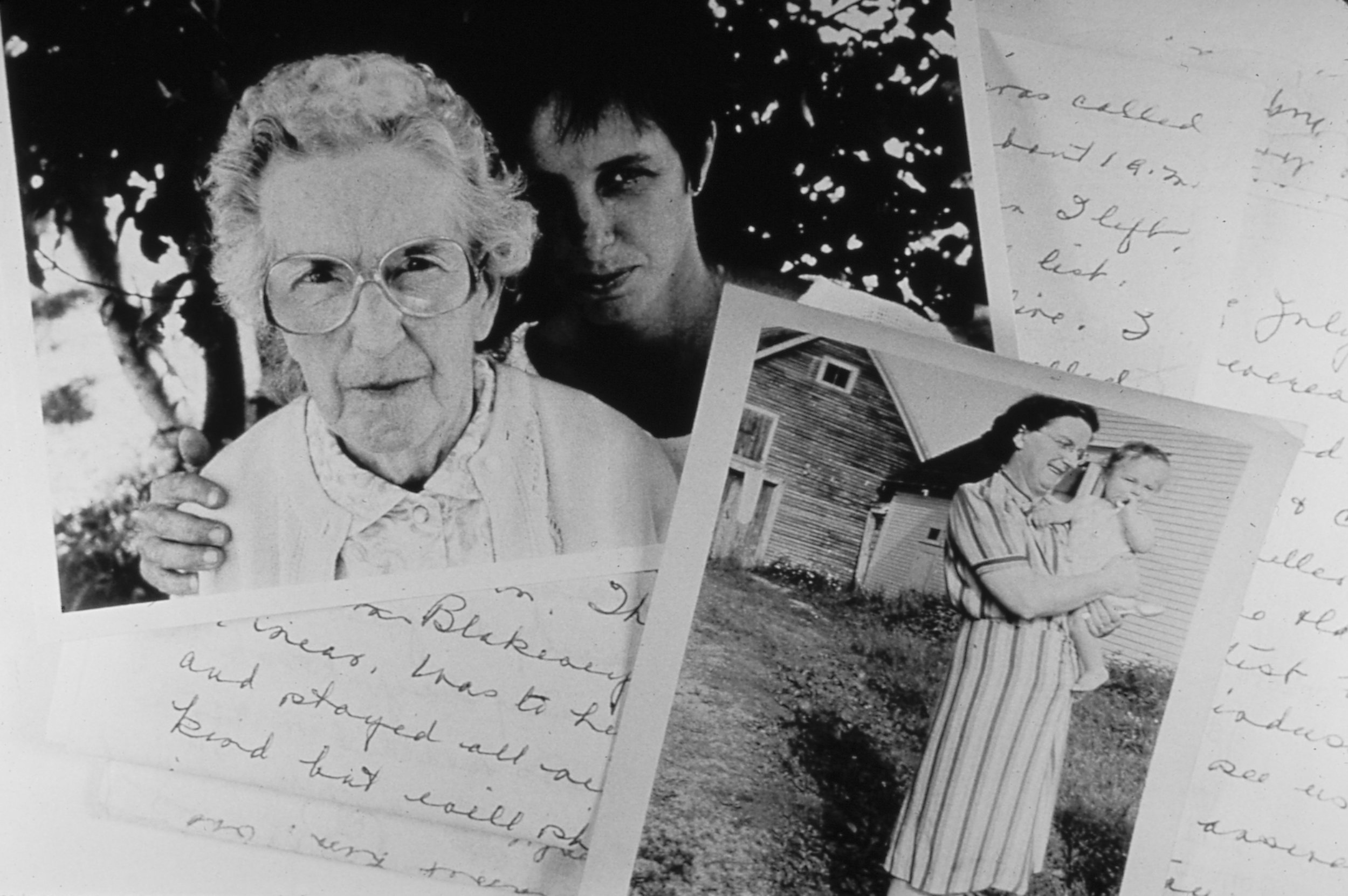Still
Still, each object, unmoving and situated in place.
Still, I am startled by what I see.
Still, not a still life, not nature morte, not a tableau that I’ve set up to photograph.
Still, everything stilled for a fraction of a moment.
Still, true photographs. Images made by light falling on and reflected off real things,
bouncing into my camera. Neither created nor enhanced by artificial means.
Still, images of land and sky and objects of rural life, a life that still exists.
Still, signs of human work, of intention, intelligence, and ingenuity.
All this still speaks to my heart, and satisfies my need to find beauty, order, purpose, and quiet.
Still, there is family farming on Prince Edward Island.
Still, I photograph.
Farm With Sunflowers, 2019
Joy and Sorrow Intertwined
With each chosen bit of natural life, I create a set, like the scene on a stage; I try out different vases or, more recently, a support, a bit of a tree trunk; for the background, I choose one of my sea and landscapes made from the shore of my homeland, Prince Edward Island. Working with natural light, adjusting and changing the stems, tucking in a petal, removing a stray branch, adding a note from an old journal that I will soon discard, I try different backdrop images looking for the right mood. I work at the time of day when the light makes a petal glow and shadows appear in the sky. I continually look through the lens of my camera, where my set always looks different – I make more adjustments. I work on composition. Meaning brews and emotions quietly swirl subconsciously. I complete my picture.
A day or so later, I get to work again: I choose the best composition from the many I made, and then after some fine-tuning, I spot it, adjust the color, and print it. I study it.
When asked, I’ve said I understand the symbolism and the metaphors, and I can imagine stories – a young family torn from their homeland, crossing to a new place, brought in and nurtured (flowers on one stem, the vase, the sea, the shadowed stormy sky all so meaningful). A cluster of young women, dressed in their finery, the party ends, tragedy strikes (fluttery orange flowers, drooping petals, an elegant and fragile vase, a sweet sunset under dark clouds). But truthfully, for me, each photograph is not a story, there is no beginning or end. Each photograph is more like a poem – a moment, an image, metaphor.
And in each one, I feel both joy and sorrow, intertwined – just as I do in my life.
Review by Cate McQuaid: https://catemcquaid.substack.com/p/the-substance-of-wisps
Close Up and Far Away — Still Lives with Plants of the Arnold Arboretum
“Close Up and Far Away” is a sort of Part Two to Inside Outside. I felt honored to be invited to make photographs with cuttings from plants of The Arnold Arboretum. I walked around, mostly with Sheryl White, their exhibition curator, who would carefully cut a few branches from the plants we chose. I took them back to my studio to photograph. What a privilege, and what a responsibility I felt to each plant to make an image worthy of its beauty.
I begin with a few stems with buds or flowers or just leaves, choose a vase and look through my photographs of Prince Edward Island (my homeland), images I made not long ago of the sea or rolling hills and sky: I depend on the natural light from my studio windows that creates reflections and shadows. These are what I work with like a stage set to make a photograph. I work on the composition, trying out different background images and arrangements, getting all the parts just right, while meaning brews subconsciously. And though I don’t fully understand it, a story reveals itself, even though it has neither an end nor clear beginning.
The main character is of course the plant life, it is the star of the show. The backstory includes the place my protagonist came from, which I learn from the Arboretum’s name tag, which could be from nearby or half-way around our planet. The sea or hills allude, I realize, to a journey – and I wonder how did my heroine (or hero) get to where they are now, what was the journey like, and, most concerning, were they welcomed and nourished, or seen as a problem, mistreated? The mood of the story is determined in part by the main character – its posture, its expression, its tone brilliant or subdued – but even more, by the sky and reflections and shadows, which I think must be memories. Hardly a story though, as it is so very ambiguous. Maybe more like a poem – a moment, an image, metaphor.
Inside Outside
The fundamental concept of this body of work, “Inside Outside,” is the juxtaposition of the human-inhabited environment with the wild, untamed natural world. Domestic life is represented by garden-grown flowers in vases and alludes to women’s work in gardens and in the home; while the outside world is seen in the images (placed behind the flowers) from my landscapes and seascapes, from a different series, called “True Poems Flee.” An equally important element is natural light. It comes from two windows and a skylight and sometimes, happily, creates reflections on the glass and shadows that could not exist against a real sky. I use all of these elements to create quietly surreal images.
A second layer has to do with mortality and beauty. The landscapes and seascapes I make are part of my series about grieving for my mother – they are expressions of sadness, love, memory, and connection. Flowers, so short-lived, their beauty so ephemeral, remind us of death and contrast with the feeling of eternity and infinitude implied by the sea and rolling hills. As it happens, my mother was an unusually beautiful woman; the metaphor is obvious.
The planet’s emergency today inevitably adds a third layer of meaning. The seas are rising; the shores will be submerged – all by our hand. The farmer’s field I lovingly photograph pollutes the local streams and ponds; a good number of the glorious flowers that I purchase are delivered to the flower market by trucks and probably airplanes that contribute to climate change. We can no longer assume that the natural world we have known is eternal.
Places for the Spirit, Traditional African American Gardens
“Places for the Spirit, Traditional African American Gardens” is a series of photographs of both gardens and the people who created them. My photographs are intended to honor and document a unique landscape aesthetic that is historically significant. Design elements within the gardens, as well as their spiritual meanings, have been traced to the cultural practices of African American people who were enslaved and farther back to their West African heritage.
I was first drawn to the gardens by their beauty, and quickly learned of their cultural and aesthetic significance. Photographing, reading, and talking with the gardeners, I learned a great deal about the traditions these yards carry — they are designed to welcome visitors, to elicit respect, and promise safety; within the yards are material objects with symbolic meanings – such as bottles, pipes, the color white, or circular objects – that are placed there to capture evil spirits, to provide a way for ancestors to communicate with the living, to invoke the deity, to reassure the visitor that despite hardship, progress will occur.
In these yards we see the gardeners’ reverence for the cycles of life and nature, for the presence of the spiritual, and for the value of community.
A book of over 80 photographs was published in 2010 by Trinity University Press.
“ Looking at these black and white images sometimes feels like dropping paper flowers in a glass of water and watching them expand. Vaughn Sills’s images make the mind expand like a rose, fragrant with vision…. [Her] humility in the face of the order she finds in these various gardens is touching – and enlightening.”
— Hilton Als
“Starting in 1987, Vaughn Sills would spend nearly two decades in the South photographing “Places for the Spirit, Traditional African American Gardens.” Sills’s 20 black-and-white photographs are as much anthropological or sociological as horticultural, except that makes them sound clinical and distanced. Instead, they are marvels of emotional gravity. Even when we don’t see the gardens’ owners, and we often do, the viewer very much feels a human presence. It’s telling that each title includes the owner’s name. Sense of place and sense of person join. And that’s leaving out what marvels these little plots of land are, equally fecund in imaginativeness of design (note the whitewashed tires in “Eula Mary Owen’s Yard, Jackson, Mississippi”) and lushness of growth. These photos would be overwhelming in color or shot with compositional busy-ness. In keeping things so (seemingly) simple, Sills honors her subject’s wondrous complexity.”
—Mark Feeney, Boston Globe
Beyond Words
I have chosen objects from nature one by one, found them, dug them, preserved them – a squirrel’s skeleton, poplar saplings that sprout from one long root, broken egg shells lying on the forest floor. I have taken them, or been given them, from the land on Prince Edward Island where my grandparents visited each summer, where I now have a cottage. I chose these things because of their extraordinary beauty – and because they seem to hold the mystery of life and death.
My family’s 1932 Oxford English Dictionary seduces me with its promise to teach, to offer knowledge, even to dispel mystery. But entrancing as it is, leading me from one word to the next, this well-used book lets me down. Words are incomplete; they fall short of conveying the miraculous presence of a squirrel’s skeleton, the complexity of a bird’s nest, the delicacy of a moth. Six letters – l, u, p, i n, e – represent the tall stemmed purple, pink, yellow and white flowered perennials whose palmated leaves turn a dusty grayish green then brown, giving way to hairy seed pods that lyrically soften the late afternoon sun by the middle of August. The word ‘lupine’ doesn’t convey what I see and love, but neither does my long string of words. A word cannot even describe the beauty of a book.
Nevertheless I need the words: they matter: they name what I see, they describe a color, a shape, an action, an attribute. Thus in my photographs I wish to portray the lure and beauty of language itself.
I have brought together objects from nature that exist outside my cottage with my dictionary, the world of our intellect. And with these I offer the artifice – the wire and pushpins and tape and thread, though sometimes barely visible – of my effort to comprehend and represent, as well as to suggest the fragility of such efforts. The construction itself has become interesting to me; it is the grammar with which I work. And yet each tableau, like each object, is delicate and cannot last. The plants will die without soil, the skeletons will fall apart, the threads will let go. The pages of the dictionary will continue to yellow; the binding, continue to loosen. Like my dreams, my beloved signs of life will eventually disappear.
One Family
Over a period of twenty years, I made portraits and collected the stories of four generations of one family, the Tooles of northeastern Georgia. Theirs is a story of hardship, perseverance, and love. Lois and Joel, who both grew up in families who had worked as tenant farmers, were in their forties and had had nine children, with the oldest 25 and the youngest seven when I met them. Tina, the youngest daughter was nine when I began photographing them in 1979; and in the years I continued to photograph and record the family history, she grew up, married, had a child, divorced, and remarried; Tina also became her mother Lois’s primary caretaker during the last years of Lois's life. In my book of the Tooles, One Family, Tina becomes the central figure, while her mother draws nearly equal attention. But equally important are Tina’s brothers and sisters, whose individual stories and portraits reveal their experiences, and show the depth of love and care they hold for each other, their parents, and their children -- with a devotion that is profound.
One Family, Georgia University Press, was published in 2001.
Knowing Our Distance
In these images, I am exploring the relationship between past and present in my life; using both old and new photographs and writing from diaries, letters, essays, or even scraps of paper, I am making photographs about the integration of memory and experience, of what was and what is.
Some of the pieces are straight prints without manipulation — perhaps feeling more “present” — although they sometimes show the aberrations of film. While in others, selective toning is used in a way to suggest the complexity of, even confusion within, experience. Altogether, this work is about the ambiguity between one’s expectations and the realities of one’s life, the mingling of past and present, the beautiful and the ordinary. The past is not different in power or in temporal meaning than the present.







